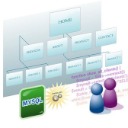
This morning I noticed that the Mozilla group has finally released Firefox 3.6 - with a stunning list of changes. Among the biggies for me:
- Protection from out-of-date plugins to keep users safer as they browse.
- Improved JavaScript performance, overall browser responsiveness, and startup time.
- Support for new CSS attributes such as gradients, background sizing, and pointer events.
- Support for new DOM and HTML5 specifications including the Drag & Drop API and the File API, which allow for more interactive web pages.
but there's a lot more there for everyone.
When there's a major update to Firefox, like this, all the themes and plugins fail until the developers have a chance to update them to the new system. This morning was no exception for me. I had to mess with quite a few things in order to get Firefox working on Mac, Windows, and Linux.
Theme Problems - Whitehart 3.6.5 [XP & Linux]
I use the Whitehart theme for XP and Linux and of course it's not ready. Sadly, there's nothing I can do here as it's not in my skill-set to mess with the theme. I'll just have to live with the default theme until they get around to updating it.
XML Rendering Problems [XP & Linux]
I need to look at the XML output of several different servlets and because the servlet's content-type is text/html as opposed to application/xhtml+xml, I don't really see the XML - just some of the unbounded data in the XML. This isn't very useful. The old plug-in I used to force a content-type switch wasn't compatible with Firefox 3.6, so I tried Force Content-Type 1.2.2. What a gem!
I simply install this, activate it, and then put in the mapping for the URLs I need using JavaScript regex and BINGO! It works like a champ! I spent nearly half a day initially trying to figure out what the problem was, but this time, this guy had me up and running in less than 15 mins. That's fast.
If you need to see XML in Firefox on XP or Linux get it.
Java Plug-in [Linux]
This was a puzzler until I started googling it... the Java plug-in for Linux for Firefox 3.6 changed from the old libjavaplugin_oji.so to the new libnpjp2.so. For the JDKs distributed from Sun, this file is in the same basic directory structure, and a simple find will find it. But there's no errors in using the old one, it just doesn't load. Switch to the new one and restart Firefox, and all is well.
This little tidbit wasn't in any of the docs I read, and I wasn't the only one that thought this was an oversight. I can't imagine that after years of using the old plugin, I'd have thought to switch on my own. I'm sure glad one of the developers spoke up on this thread. Yikes!




